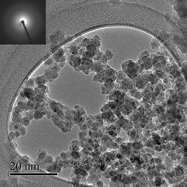Crossref Citations
This article has been cited by the following publications. This list is generated based on data provided by
Crossref.
Chen, Jiewei
King, Sean W.
Muthuswamy, Elayaraja
Koryttseva, Anastasia
Wu, Di
Navrotsky, Alexandra
and
Riedel, R.
2016.
Thermodynamic Stability of Low‐k Amorphous SiOCH Dielectric Films.
Journal of the American Ceramic Society,
Vol. 99,
Issue. 8,
p.
2752.
Stabler, Christina
Roth, Felix
Narisawa, Masaki
Schliephake, Daniel
Heilmaier, Martin
Lauterbach, Stefan
Kleebe, Hans-Joachim
Riedel, Ralf
and
Ionescu, Emanuel
2016.
High-temperature creep behavior of a SiOC glass ceramic free of segregated carbon.
Journal of the European Ceramic Society,
Vol. 36,
Issue. 15,
p.
3747.
Stabler, Christina
Ionescu, Emanuel
Graczyk‐Zajac, Magdalena
Gonzalo‐Juan, Isabel
and
Riedel, Ralf
2018.
Silicon oxycarbide glasses and glass‐ceramics: “All‐Rounder” materials for advanced structural and functional applications.
Journal of the American Ceramic Society,
Vol. 101,
Issue. 11,
p.
4817.
Ionescu, Emanuel
Sen, Sabyasachi
Mera, Gabriela
and
Navrotsky, Alexandra
2018.
Structure, energetics and bioactivity of silicon oxycarbide-based amorphous ceramics with highly connected networks.
Journal of the European Ceramic Society,
Vol. 38,
Issue. 4,
p.
1311.
Mera, Gabriela
Kroll, Peter
Ponomarev, Ilia
Chen, Jiewei
Morita, Koji
Liesegang, Moritz
Ionescu, Emanuel
and
Navrotsky, Alexandra
2019.
Metal-catalyst-free access to multiwalled carbon nanotubes/silica nanocomposites (MWCNT/SiO2) from a single-source precursor.
Dalton Transactions,
Vol. 48,
Issue. 29,
p.
11018.
Qian, Junjie
Wang, Xuan
He, Chao
Cai, Mei
Hu, Ping
Shui, Anze
and
Du, Bin
2019.
Structural evolutions and oxidation behavior of Fe-doped silicon oxycarbide nanocomposites at medium temperatures.
Ceramics International,
Vol. 45,
Issue. 18,
p.
24331.
Moldovan, Simona
Ersen, Ovidiu
Sanchez, Clément
Campostrini, Renzo
and
Sorarù, Gian Domenico
2019.
Shedding light onto the nano- and micro-structures of B-containing SiOC glasses using high resolution TEM 3D imaging.
Journal of the European Ceramic Society,
Vol. 39,
Issue. 10,
p.
3042.
Chen, Jiewei
Calvin, Jason
Asplund, Megan
King, Sean W.
Woodfield, Brian F.
and
Navrotsky, Alexandra
2019.
Heat capacities, entropies, and Gibbs free energies of formation of low-k amorphous Si(O)CH dielectric films and implications for stability during processing.
The Journal of Chemical Thermodynamics,
Vol. 128,
Issue. ,
p.
320.
Markov, Mikhail A.
Vnuk, Vyacheslav V.
Ippolitov, Evgeny V.
Kamaev, Sergey V.
and
Cherebylo, Svetlana A.
2020.
The prospects for transforming stereolithographic parts from polymer to ceramic by using powder silicium as a photocurable resin filler.
The International Journal of Advanced Manufacturing Technology,
Vol. 111,
Issue. 7-8,
p.
1863.
Navrotsky, Alexandra
Percival, John
and
Dobrzhinetskaya, Larissa
2020.
Carbon in Earth's Interior.
p.
47.
Guo, Lei
Ma, Qingsong
Hu, Zhiyu
and
Xu, Chongqing
2021.
High-temperature evolution behavior of MK silicon resin derived SiOC ceramics under different environments.
Ceramics International,
Vol. 47,
Issue. 15,
p.
21815.
Sugie, Casey
Navrotsky, Alexandra
Lauterbach, Stefan
Kleebe, Hans-Joachim
and
Mera, Gabriela
2021.
Structure and Thermodynamics of Silicon Oxycarbide Polymer-Derived Ceramics with and without Mixed-Bonding
.
Materials,
Vol. 14,
Issue. 15,
p.
4075.
Du, Bin
Wang, Anzhe
Zhang, Tao
and
Liu, Dazhao
2022.
Phase development in metal-dropped silicon oxycarbides under water vapor and argon hybrid atmosphere.
Ceramics International,
Vol. 48,
Issue. 14,
p.
19720.
Navrotsky, Alexandra
and
Leonel, Gerson J.
2023.
Thermochemistry of hybrid materials.
Philosophical Transactions of the Royal Society A: Mathematical, Physical and Engineering Sciences,
Vol. 381,
Issue. 2259,
Yi, Gang
and
Yu, Yuxi
2023.
Molecular Aggregation Strategy for Pore Generation in SiOC Ceramics Induced by the Conjugation Force of Phenyl.
Polymers,
Vol. 15,
Issue. 12,
p.
2676.
Nakano, Yuki
Kimura, Yuki
and
Hashimoto, Akihiko
2024.
Diverse features of dust particles and their aggregates inferred from experimental nanoparticles.
Monthly Notices of the Royal Astronomical Society: Letters,
Vol. 531,
Issue. 1,
p.
L69.



